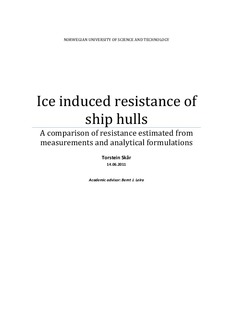Ice induced resistance of ship hulls: A comparison of resistance estimated from measurements and analytical formulations
Master thesis
Permanent lenke
http://hdl.handle.net/11250/237952Utgivelsesdato
2011Metadata
Vis full innførselSamlinger
- Institutt for marin teknikk [3397]
Sammendrag
Due to global warming and hydrocarbon exploration in the Arctic areas, there is an increasing maritime activity in ice infested waters. Today one can with good accuracy predict if a vessel will be able to survive an encounter with ice of a given thickness, but the knowledge is not good enough to predict the increased fuel cost for ice navigation.
This thesis has investigated the validity of two analytical formulations for ice resistance in Arctic areas. The formulations are based on full-scale ice trials in the Finnish-Swedish waters, which have lower salinity and warmer climate than the Arctic areas. This is done by comparing the resistance estimated from onboard measurements of vessel speed, ice thickness and engine power with the estimates from the analytical formulations. The ratio between the two is investigated using statistical tools.
While most of the data have too much variation for any conclusions to be made, some time sequences without large variation in the resistance has been identified. Analysis from these sequences indicate that the formulation presented by Riska et al. (1997) appears to be able to describe the speed dependency of ice resistance in the Arctic, but is inaccurate when describing the ice thickness dependence. The formulation presented by Lindqvist (1989) is found to be inaccurate when describing both ice thickness and speed dependency.
It is unclear whether the source of inaccuracy comes from incorrect ice property values or if the formulations have been used outside their area of application (both are based on ice trials in the Baltic Sea).
